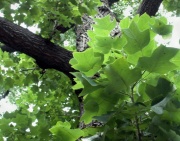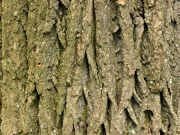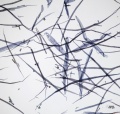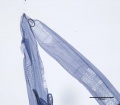Difference between revisions of "Tulip tree"
m (Text replace - "\[http:\/\/cameo\.mfa\.org\/materials\/fullrecord\.asp\?name=([^\s]+)\s(.*)\]" to "$2") |
|||
| Line 1: | Line 1: | ||
| − | [[File:Tuliptree_leaves.jpg|thumb|Tulip tree | + | [[File:Tuliptree_leaves.jpg|thumb|Tulip tree (''Liriodendron tulipifera'')]] |
| − | |||
| − | (''Liriodendron tulipifera'')]] | ||
== Description == | == Description == | ||
A tall, hardwood magnolia tree, ''Liriodendron tulipifera'', native to the Atlantic coast of North America. Tulip trees have a soft, lightweight wood with a pale yellow to green brown color. It was used in the 19th century for house construction (framing and shingles). Tulip tree wood was later used for furniture, inlays, painting panels, [[veneer|veneer]], and toys. The leaves of the tulip tree contain a [[dye|dye]] that gives a strong gold color with a chrome [[mordant|mordant]]. It has fair lightfastness. | A tall, hardwood magnolia tree, ''Liriodendron tulipifera'', native to the Atlantic coast of North America. Tulip trees have a soft, lightweight wood with a pale yellow to green brown color. It was used in the 19th century for house construction (framing and shingles). Tulip tree wood was later used for furniture, inlays, painting panels, [[veneer|veneer]], and toys. The leaves of the tulip tree contain a [[dye|dye]] that gives a strong gold color with a chrome [[mordant|mordant]]. It has fair lightfastness. | ||
| − | [[File:Tuliptree_bark.jpg|thumb|Tulip tree | + | [[File:Tuliptree_bark.jpg|thumb|Tulip tree (''Liriodendron tulipifera'')]] |
| − | |||
| − | (''Liriodendron tulipifera'')]] | ||
== Synonyms and Related Terms == | == Synonyms and Related Terms == | ||
''Liriodendron tulipifera''; tulipier de Virginie (Fr.); tulipier (Fr.); liriodendron (Fr.); tulipero (Esp.); tulipeiro (Port.); Liriodendro (It.); Albero dei tulipani (It.); yellow poplar; tulip poplar; saddleleaf tree; whitewood; canary whitewood | ''Liriodendron tulipifera''; tulipier de Virginie (Fr.); tulipier (Fr.); liriodendron (Fr.); tulipero (Esp.); tulipeiro (Port.); Liriodendro (It.); Albero dei tulipani (It.); yellow poplar; tulip poplar; saddleleaf tree; whitewood; canary whitewood | ||
| − | == | + | == Physical and Chemical Properties == |
| − | |||
| − | |||
| − | + | * Annuals rings are not distinct. | |
| − | + | * Grain = fine. | |
| − | + | * Texture = fine | |
| − | + | * Density = 30 ppcf | |
| − | |||
Paper fiber type: hardwood, diffuse porous. Using transmitted light microscopy, pulp is identified by the presence of numerous long vessels with opposite, crowded pitting. Pits may be in vertical or horizontal rows. Perforations are scalariform with <10 bars. Appearance with [[Graff "C" stain]]: dark blue, but varies with bleaching. Average dimensions of fibers: length 1.9mm, 24-40μm wide. Common pulping method: [[kraft process|kraft]]. | Paper fiber type: hardwood, diffuse porous. Using transmitted light microscopy, pulp is identified by the presence of numerous long vessels with opposite, crowded pitting. Pits may be in vertical or horizontal rows. Perforations are scalariform with <10 bars. Appearance with [[Graff "C" stain]]: dark blue, but varies with bleaching. Average dimensions of fibers: length 1.9mm, 24-40μm wide. Common pulping method: [[kraft process|kraft]]. | ||
| Line 33: | Line 26: | ||
</gallery> | </gallery> | ||
| − | == | + | ==Resources and Citations== |
* R. J. Gettens, G.L. Stout, ''Painting Materials, A Short Encyclopaedia'', Dover Publications, New York, 1966 | * R. J. Gettens, G.L. Stout, ''Painting Materials, A Short Encyclopaedia'', Dover Publications, New York, 1966 | ||
| Line 39: | Line 32: | ||
* ''Dictionary of Building Preservation'', Ward Bucher, ed., John Wiley & Sons, Inc., New York City, 1996 | * ''Dictionary of Building Preservation'', Ward Bucher, ed., John Wiley & Sons, Inc., New York City, 1996 | ||
| − | * ''Encyclopedia Britannica'', http://www.britannica.com Comment: "Tulip Tree." | + | * ''Encyclopedia Britannica'', http://www.britannica.com Comment: "Tulip Tree." Accessed 21 May 2004 . |
* G.S.Brady, ''Materials Handbook'', McGraw-Hill Book Co., New York, 1971 Comment: p. 825 | * G.S.Brady, ''Materials Handbook'', McGraw-Hill Book Co., New York, 1971 Comment: p. 825 | ||
| Line 47: | Line 40: | ||
* Random House, ''Webster's Encyclopedic Unabridged Dictionary of the English Language'', Grammercy Book, New York, 1997 | * Random House, ''Webster's Encyclopedic Unabridged Dictionary of the English Language'', Grammercy Book, New York, 1997 | ||
| − | * | + | * Hardwood Manufacturers Institute, Memphis, Tenn.: air-dry weight = 28 pcf |
* ''The American Heritage Dictionary'' or ''Encarta'', via Microsoft Bookshelf 98, Microsoft Corp., 1998 | * ''The American Heritage Dictionary'' or ''Encarta'', via Microsoft Bookshelf 98, Microsoft Corp., 1998 | ||
Revision as of 14:02, 21 June 2022
Description
A tall, hardwood magnolia tree, Liriodendron tulipifera, native to the Atlantic coast of North America. Tulip trees have a soft, lightweight wood with a pale yellow to green brown color. It was used in the 19th century for house construction (framing and shingles). Tulip tree wood was later used for furniture, inlays, painting panels, Veneer, and toys. The leaves of the tulip tree contain a Dye that gives a strong gold color with a chrome Mordant. It has fair lightfastness.
Synonyms and Related Terms
Liriodendron tulipifera; tulipier de Virginie (Fr.); tulipier (Fr.); liriodendron (Fr.); tulipero (Esp.); tulipeiro (Port.); Liriodendro (It.); Albero dei tulipani (It.); yellow poplar; tulip poplar; saddleleaf tree; whitewood; canary whitewood
Physical and Chemical Properties
- Annuals rings are not distinct.
- Grain = fine.
- Texture = fine
- Density = 30 ppcf
Paper fiber type: hardwood, diffuse porous. Using transmitted light microscopy, pulp is identified by the presence of numerous long vessels with opposite, crowded pitting. Pits may be in vertical or horizontal rows. Perforations are scalariform with <10 bars. Appearance with Graff "C" stain: dark blue, but varies with bleaching. Average dimensions of fibers: length 1.9mm, 24-40μm wide. Common pulping method: kraft.
Additional Images
Resources and Citations
- R. J. Gettens, G.L. Stout, Painting Materials, A Short Encyclopaedia, Dover Publications, New York, 1966
- Dictionary of Building Preservation, Ward Bucher, ed., John Wiley & Sons, Inc., New York City, 1996
- Encyclopedia Britannica, http://www.britannica.com Comment: "Tulip Tree." Accessed 21 May 2004 .
- G.S.Brady, Materials Handbook, McGraw-Hill Book Co., New York, 1971 Comment: p. 825
- Van Nostrand's Scientific Encyclopedia, Douglas M. Considine (ed.), Van Nostrand Reinhold, New York, 1976
- Random House, Webster's Encyclopedic Unabridged Dictionary of the English Language, Grammercy Book, New York, 1997
- Hardwood Manufacturers Institute, Memphis, Tenn.: air-dry weight = 28 pcf
- The American Heritage Dictionary or Encarta, via Microsoft Bookshelf 98, Microsoft Corp., 1998
- George Savage, Art and Antique Restorer's Handbook, Rockliff Publishing Corp, London, 1954
- Marja-Sisko Ilvessalo-Pfäffli. Fiber Atlas: Identification of Papermaking Fibers (Springer Series in Wood Science). Springer, 1995.
- Walter Rantanen. "Fiber ID Course." Integrated Paper Services. June 2013. Lecture.




